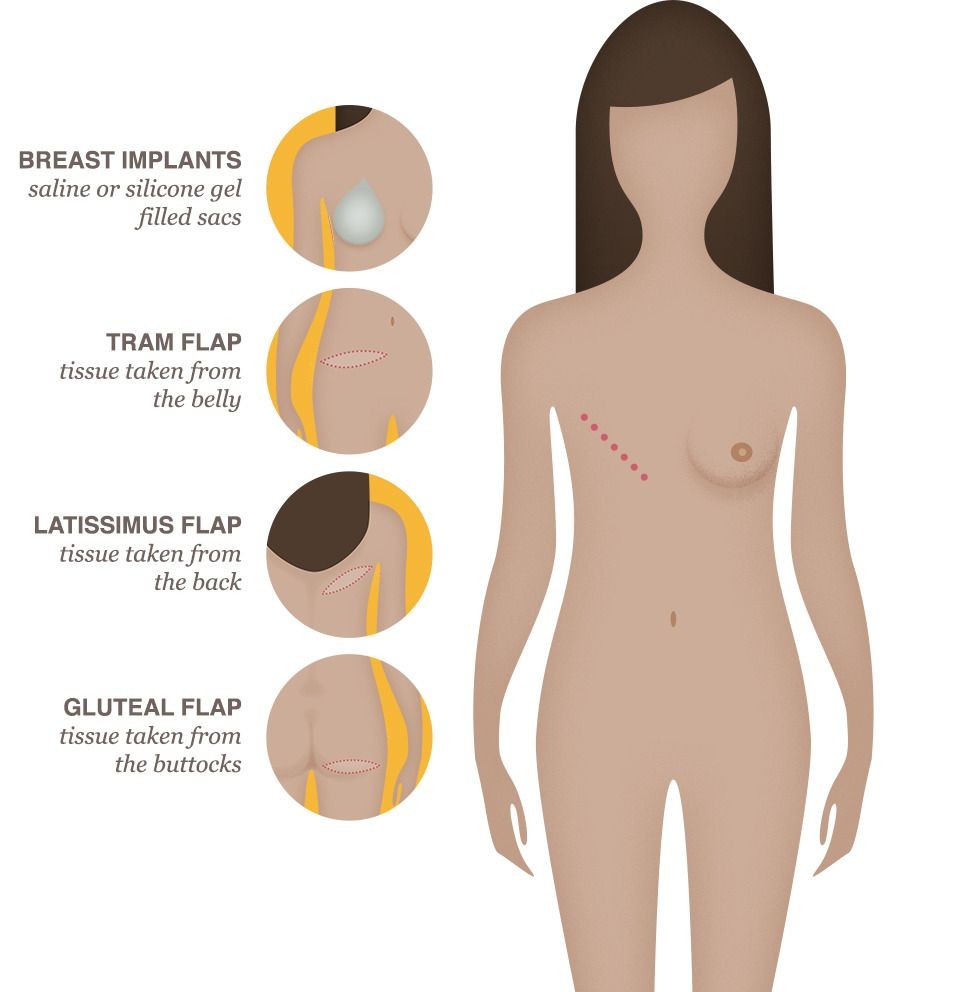Breast reconstruction is to reform or reshape the breast(s) after a mastectomy or lumpectomy. A mastectomy is a surgical procedure that removes the entire breast, usually including the nipple and areola, in order to treat or prevent breast cancer. A lumpectomy is the removal of a piece of the breast where there is a smaller tumor. This reconstruction process can help a woman find her self-confidence again and feel better during her cancer recovery.
While many factors determine what kind of breast reconstruction surgery would best suit an individual, there are two main types of breast reconstruction surgery:
- Flap Reconstruction – Autologous / Skin Flap Surgery
- Tissue Expander – Implants / Prosthetics

The Procedure
Contents
The procedure for both these methods differs from each other. Both begin with anesthetizing the patient so that she may not suffer from pain and discomfort during the surgery. After this, the procedures go as follows:
- Flap reconstruction: in this technique, a tissue flap is taken from a donor site on your body, such as the abdomen, thighs, buttocks or back. The flap is grafted at the place of your breasts. Its blood supply can either be taken from the donor site or it can be cut off from there and a new supply is established. In both cases, nutrition of the flap is not disturbed. Stitches are applied, drainage tubes are inserted to drain excess fluid or blood from the site and bandages are applied over it.
- A tissue expander (breast implant): this is the most common technique used worldwide. A synthetic implant is inserted under the pectoralis major muscle. Silicone implants are most commonly used. Animal dermal grafts are used to cover the site to give it a more aesthetic appearance. Within a few months, saline solution is injected to expand the tissue until it reaches the appropriate size.
Following these surgeries, other procedures can be carried out to reconstruct a nipple. Nipple prosthesis is used to restore the normal physical appearance of your breasts.
Length of Stay in Destination
The actual procedure and time needed in the operation theatre differ for the two types of breast reconstructive surgeries mentioned above, with the breast implant procedure taking less time as compared to flap reconstruction. One or two days of stay is needed in the hospital after tissue expander surgery. While flap reconstruction is more like two or three days stay at the hospital. Follow-ups are needed for both of these. You should stay in the Country for at least 14 days after the surgery. During this period, your health condition is monitored, stitches and drainage tubes are removed and you can go home when allowed by your physician.
Recovery Time
Your period of recovery depends upon the type of reconstructive surgery you have. A couple of weeks are needed by most of the women to recover. There are swelling and soreness around the site in the first week. This continues to reduce and ultimately, after 8 weeks you should start to see signs of a full recovery. Medicines are given to relieve pain and discomfort. You will need to take 2-3 weeks off work. On average, 3-4 weeks are needed to recover from tissue expander surgery and 4-6 weeks for flap reconstructive surgery. Wear surgical bras to support your reconstructed breasts while you are recovering. Regular activities can be restarted after 2 months. Almost 1-2 years are required to get the proper shape and for the scars to fade away.
Success Rate
Breast reconstruction surgery has a high success rate, with complications usually only occurring in case of infection or a blood clot formation. According to a study by the American Society of Plastic Surgeons, the success rate is found to be 98% in case of flap reconstruction surgery. While for tissue expander surgery has a success rate within the region of 94-96%. Owing to its tremendous success rate, the percentage of women going through the surgery is increasing day by day.
Aftercare
The following points should be considered post-operation:
- Follow the instructions given by your doctor and take your medicines as and when prescribed.
- Consult a nutritionist for a diet plan. A healthy diet helps you recover faster.
- Do not wear a padded or underwire bra until allowed by your doctor.
- Use surgical bras in the early few days after the surgery.
- Avoid excessive unnecessary movement of your breasts.
- Do not lift heavy objects and children – it could stretch on your stitches.
- Change your bandage whenever it gets dirty. Germs can cause infection.
- Do not take a bath when the bandages are still intact. A wet bandage can also be the cause of infection.
- Abstain from sexual activity for at least 6 weeks.
- Take rest – give yourself time to recover.
Alternatives to a Breast Reconstruction Procedure
Surgery should never be the first option. Other options should always be considered before opting for it. Following are some alternatives to breast reconstruction surgery:
- Breast prosthetics: prosthetic breasts can be worn inside your bras or they can be attached to your body. They give the appearance of natural breasts.
- Padded bras: these are not as uncomfortable as prosthetic breasts. They give you a perfect body posture without going through the surgery.
- Go flat: you can embrace your freedom. Accept yourself as you are. No need to wear padded bras or prosthetic breasts. No need to go through surgery.
For an in-depth analysis of the Tissue Expander process, watch this short video.
Patient reviews often refer to be being pleased with the level of professionalism and emotional support throughout the entire process leading up to and following the surgery. Often the increase in self-confidence is considered the biggest positive from the procedure. Before and after photos are available online with patient comments.
To check prices or to book a Breast Reconstruction Procedure in Thailand or anywhere else in the world, head on over to MyMediTravel now!

